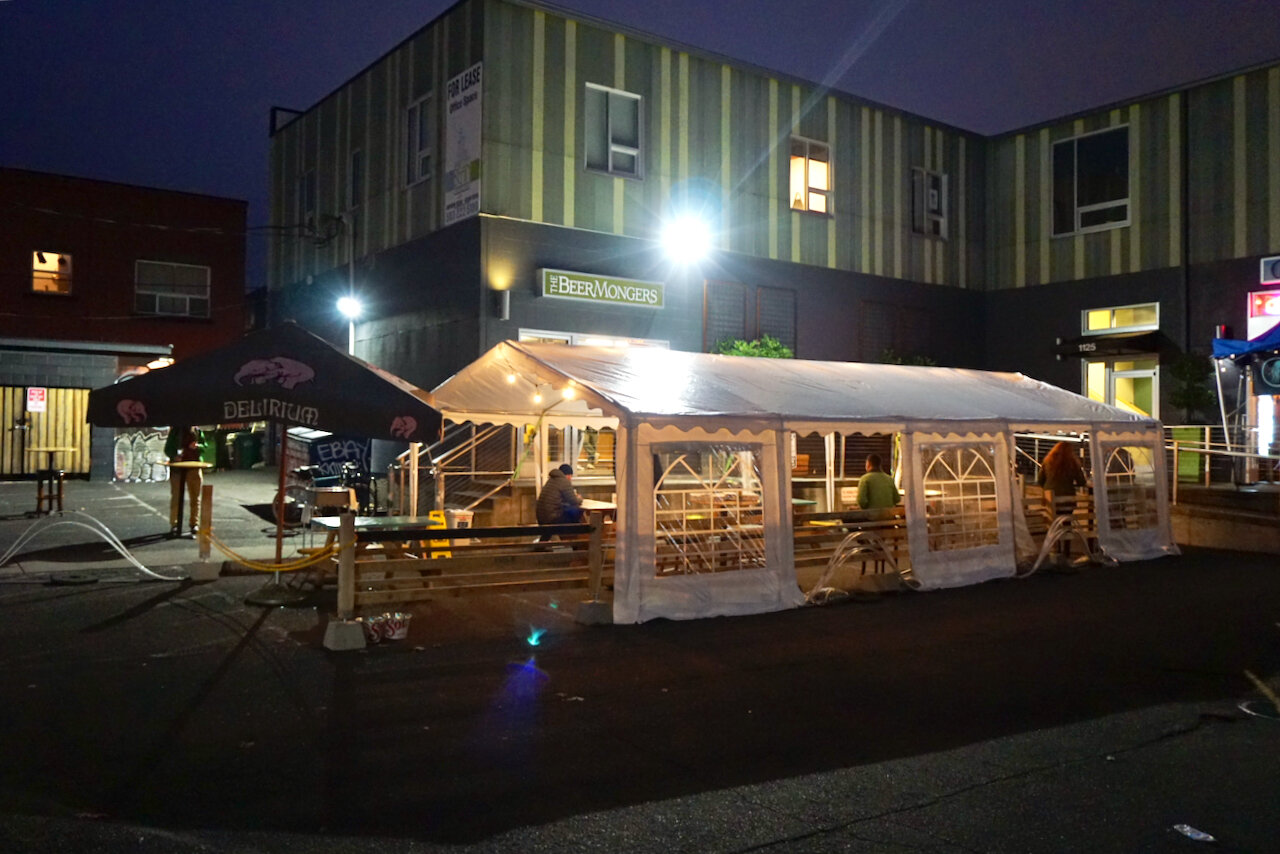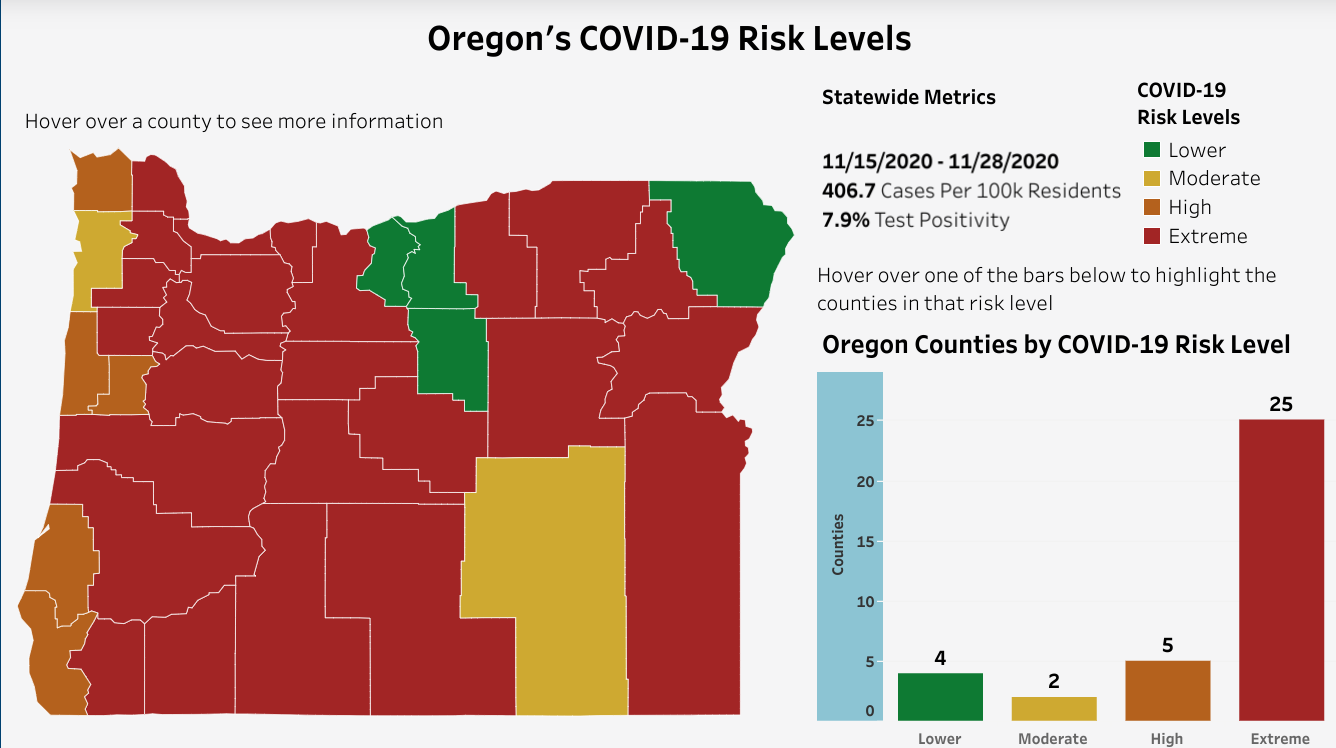Confusion over Oregon’s Outdoor Seating rules make for difficult Reopening
Oregon will emerge from a 2-week “freeze” on any and all on-premise indoor and outdoor eating and drinking this Thursday, December 3rd. The majority of Oregon’s counties will remain classified into an “Extreme Risk” category that bans indoor seating but allows outdoor eating and drinking with some unexpected limitations. Many taproom and restaurant owners are still unaware that the new restrictions won’t allow them to use their covered and insulated outdoor setups because of a little publicized rule regarding how many wall panels they have.
Oregon’s most populous counties including Portland, Clackamas, Deschutes, Lane and Hood River won’t be able to reopen indoor seating at all while they remain in the Extreme Risk sector. Outdoor seating will be limited to 50 total people, and groups of no more than 6. What hasn’t been clear is the Oregon Health Authority’s (OHA) is enforcing a rule that requires 3 of any 4 walled structures to be open to the air. Many outdoor parklet setups have the exact opposite; with three enclosed walls and one open. The Oregon Restaurant & Lodging Association (ORLA) clarified these rules with the OHA this week:
Based on the latest definition from the Oregon Health Authority, “outdoor space” means an open-air space which may have a temporary or fixed cover, such as an awning or roof, so long as the space has at least 75% of the square footage of its sides open for airflow.
These stipulations for “outdoor space” can not be found in the guidance published by the Governor that includes the new county metric risk system and a list of what can and cannot be done under those limitations. When the New School reached out to brewery and beer bar owners across the state, some were completely unaware of the rules on their outdoor space:
“This is the first I’ve heard of this. We haven’t had customers indoors since March 17, we’re trying to hang in for a tough winter,” said Bryce Morrow of Oregon City Brewing.
“We hadn't seen that guidance yet,” admitted Matt Swihart, owner of Double Mountain Brewing with locations in Hood River and Portland. Swihart’s pubs actually already meet the outdoor requirements and he has been an outspoken advocate on restrictions but also for state and federal relief money. “It's a bummer, for sure, for restaurants that have physically invested in structures that don't adhere to these open air requirements, but I also respect the health authorities to make decisions that keep our community safe.”
Other brewery owners were tipped off to the stipulations by the ORLA reps and an update on the situation that was only published 2 days ago on Tuesday, December 1st.
“I did read in the guidelines about the tent walls and agree that it isn't getting much press. I thought Kate Brown was supposed to make further announcements this week, but haven't heard anything, other than Deschutes County is Extreme Risk.” said Ty Barnett, co-owner of Bend, Oregon’s Goodlife Brewing.
“it’s unfortunate that we’ll have to leave the walls off. Our main concern is the heater and the waste associated. We’re going to add shade sails over our bay so there is extra covered space. Hopefully Oregonians will be happy to don some gay apparel and brave the cold to try our new barrel-aged saison and smoothie IPA,” says Travis Preece of Portland’s Gorges Beer Co.
The definitions of what is and what is not considered an open or enclosed outdoor area is not new to bars and restaurants with smokers patios —something that you will rarely find at a taproom or restaurant. The rules relate to the Indoor Clean Air Act (ICAA) that was adopted by the Oregon Legislature in 2017 that requires workplaces and public places to be smoke, vapor, and aerosol free.
The Oregon Legislature defined "enclosed area" in statute as:
"...the entirety of the space between a floor and ceiling that is enclosed on three or more sides by permanent or temporary walls or windows, exclusive of doors or passageways, that extend from the floor to the ceiling." (ORS 433.835)
The Oregon Health Authority is in charge of enforcing the ICAA, and to be considered a “not enclosed” space you have to have no more than a roof and one wall, examples are provided at their Enclosed Areas and the ICC guide.
UPDATE 12/4/2020: the Oregon Health Authority updated their restaurant guidelines with the following official rules on what is considered a permissable outdoor area: • “Outdoor” means any open-air space including any space which may have a temporary or fixed cover (e.g. awning or roof) and at least seventy-five percent of the square footage of its sides open for airflow.
It’s unclear how much actual enforcement of the “outdoor space” rules will take place. Some bars and restaurants are just as concerned about the enclosed patios becoming no different than indoor spaces stale air where droplets potentially containing COVID-19 could circulate for hours.
“Its unreasonable and unenforceable,” added Brendan Greenen of Grains of Wrath Brewing. GOW is considering putting up an outdoor tent and street parklet after already being approved by Portland’s safe streets initiative. “There are 100's of businesses who have already invested a ton of time, energy and money into building 3 walled structures before this shutdown. I don't believe that there is any way to push all of these small businesses to rip those down and build new to the standard or to modify those enclosures they made. Additionally, if there is gaps on top and underneath the walls, as most I have seen have, then their is more than adequate air flow throughout the spaces. They are simply providing a little bit of wind barrier for people to be a little comfortable.”
“It seems to me that airflow is the reason outdoor dining is safer and it defeats the purpose if you are in an enclosed space,” says Sean Campbell, owner of Portland’s popular beer bar and bottle shop The Beermongers. “As you have seen we have three of the twelve panels on our 16’ by 32’ tent so without exactly planning it sounds like 75% to me. We do not plan on using heaters so customers will have to bundle up. I am concerned about people crowding around heaters and not maintaining distance. Also the cost of heating a space with a lot of airflow!”
“I am not reopening since I took down my tents and cancelled my orders for heaters,” says Brian Koch, owner of St. Johns beer bar Lombard House. “Thankfully they were on back order. I have ZERO faith in anyone actually checking out those structures though, sound say you should open with what you have.”
“We’re gonna give it a go. Invested 8k into tent we can’t really use now. We will have one wall up,” remarked John Harris of Ecliptic Brewing.
There are other operations that seem unfazed and are pushing forward on their reopening plans, some that invested heavily in outdoor seating and others that already had appropriate spaces.
“We decided early in this pandemic to invest in a large high quality tent for the winter,” says Tomas Sluiter of Culmination Brewing in Portland. “Permanent overhead heating for the tent is on its way and will be installed in the coming weeks. Being almost 900 square feet, we can comfortably distance people and tables. We will keep upgrading the tent through the winter, including installing a living wall on one side to bring some visual warmth. It’s going to be a long winter, but as long as we feel it’s safe for our customers and staff, and are able to follow current state and CDC safety guidelines we will do our best to stay open.”
“We plan on allowing guests to hang out around the fire pits outside starting Thursday. We'll be keeping a close eye on keeping the guest count to under 50 and have the inside set up for a one-way flow to make social distancing easy. We will also have a 20x40 tent with picnic tables underneath, but as you said, we can only wall one side so dress warm!” says Jason Randles, spokesmen for Crux Fermentation Project in Bend..
One thing is clear: even though Oregon may be technically leaving the “freeze” it’s still going to be a very chilly winter for bars, restaurants and breweries.





